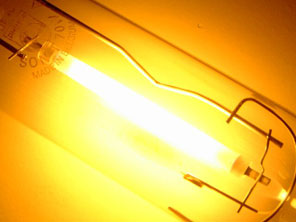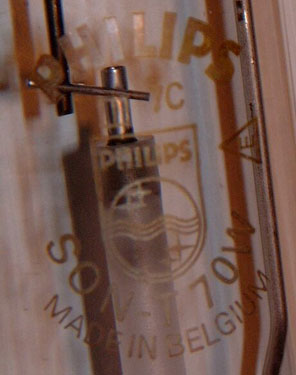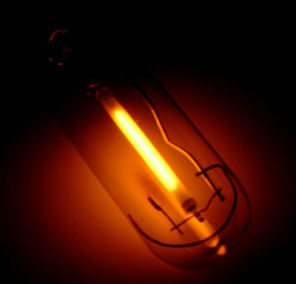Last change: September 03 2019
Philips SON-T 70W
Video at bottom of page.

One thing I discovered when trying to capture HPS on video is that it's extremely difficult to make the colour look anything like the lamp really looks. The two pictures above look more like the monochromatic yellow light you get from a LPS lamp. I've had better results with HPS pictures using 'real' film than a CCD- based camera, however it's a CCD camera used here. Conversely, a CCD camera gives much better results with mercury lamps than film...
Despite the ceramic arc tube being only translucent, in the picture on the right you can see the length of the arc more clearly.
Here's the video
Click here for the video (Realvideo) if you're still living in 1996. As with the other lamp videos here, the elapsed time is displayed bottom left (on the Realvideo version only). The first 40 seconds or so are in real time, after that it speeds up so the following 3 minutes of warm up are compressed into 30 secs. The switching off and cooling are in real time.
When the lamp starts you can see a bright purple discharge which disappears after the first couple of seconds. This is Xenon gas, which is added in order to facilitate starting. The colour then changes to the monochromatic yellow familiar with LPS lamps, then as the pressure in the arc tube rises, the colour changes to the more familiar salmon (?) colour accociated with these lamps. Look at the reflection from the bottom, rather than the tube itself to get a better idea of the colour. At switch off, notice how the ceramic arc tube holds it's heat for a long time- glowing red for much longer than quartz or glass tubes in mercury or metal halide lamps.
When the lamp starts you can see a bright purple discharge which disappears after the first couple of seconds. This is Xenon gas, which is added in order to facilitate starting. The colour then changes to the monochromatic yellow familiar with LPS lamps, then as the pressure in the arc tube rises, the colour changes to the more familiar salmon (?) colour accociated with these lamps. Look at the reflection from the bottom, rather than the tube itself to get a better idea of the colour. At switch off, notice how the ceramic arc tube holds it's heat for a long time- glowing red for much longer than quartz or glass tubes in mercury or metal halide lamps.


